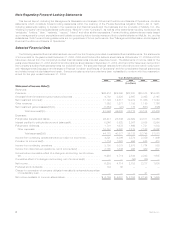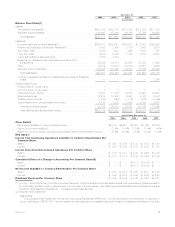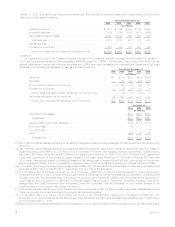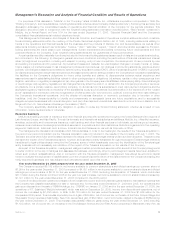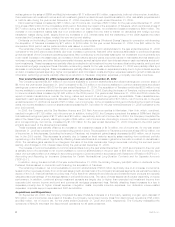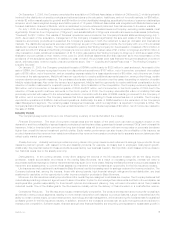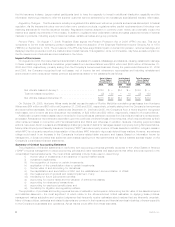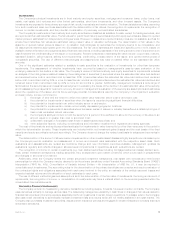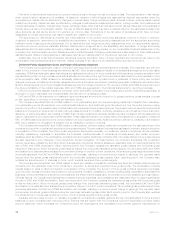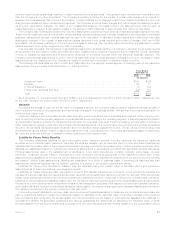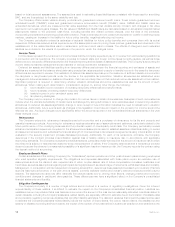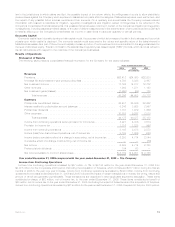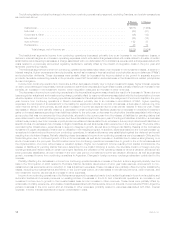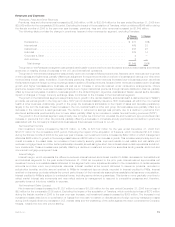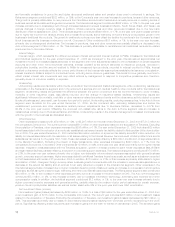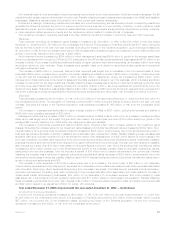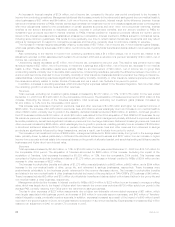MetLife 2006 Annual Report Download - page 15
Download and view the complete annual report
Please find page 15 of the 2006 MetLife annual report below. You can navigate through the pages in the report by either clicking on the pages listed below, or by using the keyword search tool below to find specific information within the annual report.based on total expected assessments. The assumptions used in estimating these liabilities are consistent with those used for amortizing
DAC, and are thus subject to the same variability and risk.
The Company offers certain variable annuity products with guaranteed minimum benefit riders. These include guaranteed minimum
withdrawal benefit (“GMWB”) riders and guaranteed minimum accumulation benefit (“GMAB”) riders. GMWB and GMAB riders are
embedded derivatives, which are measured at fair value separately from the host variable annuity contract, with changes in fair value
reported in net investment gains (losses). The fair values of GMWB and GMAB riders are calculated based on actuarial and capital market
assumptions related to the projected cash flows, including benefits and related contract charges, over the lives of the contracts,
incorporating expectations concerning policyholder behavior. These riders may be more costly than expected in volatile or declining equity
markets, causing an increase in the liability for future policy benefits, negatively affecting net income.
The Company periodically reviews its estimates of actuarial liabilities for future policy benefits and compares them with its actual
experience. Differences between actual experience and the assumptions used in pricing these policies, guarantees and riders and in the
establishment of the related liabilities result in variances in profit and could result in losses. The effects of changes in such estimated
liabilities are included in the results of operations in the period in which the changes occur.
Income Taxes
Income taxes represent the net amount of income taxes that the Company expects to pay to or receive from various taxing jurisdictions
in connection with its operations. The Company provides for federal, state and foreign income taxes currently payable, as well as those
deferred due to temporary differences between the financial reporting and tax bases of assets and liabilities. The Company’s accounting for
income taxes represents management’s best estimate of various events and transactions.
Deferred tax assets and liabilities resulting from temporary differences between the financial reporting and tax bases of assets and
liabilities are measured at the balance sheet date using enacted tax rates expected to apply to taxable income in the years the temporary
differences are expected to reverse. The realization of deferred tax assets depends upon the existence of sufficient taxable income within
the carryback or carryforward periods under the tax law in the applicable tax jurisdiction. Valuation allowances are established when
management determines based on available information, that it is more likely than not that deferred income tax assets will not be realized.
Significant judgment is required in determining whether valuation allowances should be established as well as the amount of such
allowances. When making such determination, consideration is given to, among other things, the following:
(i) future taxable income exclusive of reversing temporary differences and carryforwards;
(ii) future reversals of existing taxable temporary differences;
(iii) taxable income in prior carryback years; and
(iv) tax planning strategies.
The Company may be required to change its provision for income taxes in certain circumstances. Examples of such circumstances
include when the ultimate deductibility of certain items is challenged by taxing authorities or when estimates used in determining valuation
allowances on deferred tax assets significantly change or when receipt of new information indicates the need for adjustment in valuation
allowances. Additionally, future events such as changes in tax legislation could have an impact on the provision for income tax and the
effective tax rate. Any such changes could significantly affect the amounts reported in the consolidated financial statements in the year
these changes occur.
Reinsurance
The Company enters into reinsurance transactions as both a provider and a purchaser of reinsurance for its life and property and
casualty insurance products. Accounting for reinsurance requires extensive use of assumptions and estimates, particularly related to the
future performance of the underlying business and the potential impact of counterparty credit risks. The Company periodically reviews
actual and anticipated experience compared to the aforementioned assumptions used to establish assets and liabilities relating to ceded
and assumed reinsurance and evaluates the financial strength of counterparties to its reinsurance agreements using criteria similar to that
evaluated in the security impairment process discussed previously. Additionally, for each of its reinsurance contracts, the Company
determines if the contract provides indemnification against loss or liability relating to insurance risk, in accordance with applicable
accounting standards. The Company reviews all contractual features, particularly those that may limit the amount of insurance risk to which
the reinsurer is subject or features that delay the timely reimbursement of claims. If the Company determines that a reinsurance contract
does not expose the reinsurer to a reasonable possibility of a significant loss from insurance risk, the Company records the contract using
the deposit method of accounting.
Employee Benefit Plans
Certain subsidiaries of the Holding Company (the “Subsidiaries”) sponsor pension and other postretirement plans covering employees
who meet specified eligibility requirements. The obligations and expenses associated with these plans require an extensive use of
assumptions such as the discount rate, expected rate of return on plan assets, rate of future compensation increases, healthcare cost
trend rates, as well as assumptions regarding participant demographics such as rate and age of retirements, withdrawal rates and mortality.
Management, in consultation with its independent consulting actuarial firm, determines these assumptions based upon a variety of factors
such as historical performance of the plan and its assets, currently available market and industry data and expected benefit payout
streams. The assumptions used may differ materially from actual results due to, among other factors, changing market and economic
conditions and changes in participant demographics. These differences may have a significant effect on the Company’s consolidated
financial statements and liquidity.
Litigation Contingencies
The Company is a party to a number of legal actions and is involved in a number of regulatory investigations. Given the inherent
unpredictability of these matters, it is difficult to estimate the impact on the Company’s consolidated financial position. Liabilities are
established when it is probable that a loss has been incurred and the amount of the loss can be reasonably estimated. Liabilities related to
certain lawsuits, including the Company’s asbestos-related liability, are especially difficult to estimate due to the limitation of available data
and uncertainty regarding numerous variables that can affect liability estimates. The data and variables that impact the assumptions used
to estimate the Company’s asbestos-related liability include the number of future claims, the cost to resolve claims, the disease mix and
severity of disease in pending and future claims, the impact of the number of new claims filed in a particular jurisdiction and variations in the
12 MetLife, Inc.


